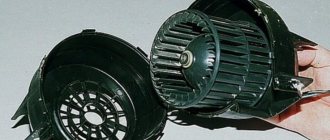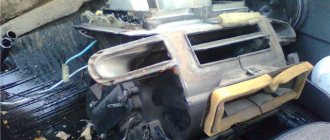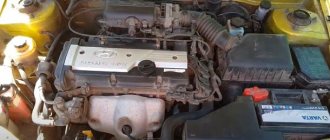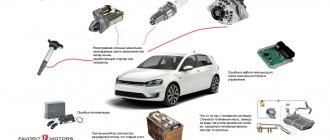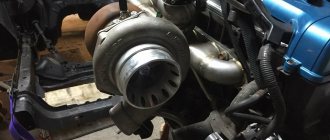A car as a means of transportation - this current slogan implies its use throughout the entire calendar year. The modern rhythm of life really forces you to get into the car, regardless of the time of day and current weather conditions. But in Russian conditions in winter they can be quite severe. And if it’s cold outside, then the driver and passengers will feel uncomfortable inside the car if the heating system is not working well enough. Unfortunately, such situations are not so rare. But if the stove starts blowing cold air, this does not mean that the problem will disappear on its own as suddenly as it appeared.
Long warm-up
The operation of the stove depends on many factors, including the health of the engine cooling system. The heater radiator is located on the antifreeze circulation line and serves, among other things, as an additional source of cooling for the power unit. Antifreeze at a temperature of 90 degrees enters the cabin radiator and, cooling in it, is able to heat the cabin even in severe frosts. True, for the stove to work effectively, the engine must also be hot.
Question and answer Why is it necessary to turn on the car heater in the heat? Warming up the engine of cars takes different times. The larger the volume of the combustion chambers, the higher their heat transfer. Small subcompact engines with a volume of 1.2 liters and 1.4 liters, equipped with turbocharging, have a very high efficiency, which is why most of the heat goes into mechanical work. The stove warms up slowly. Sometimes you have to wait about 10 minutes until the stove starts producing hot streams of air. This is completely normal and is not a cause for concern.
For atmospheric units with a volume of 1.6 liters, the heat transfer is noticeably higher. They consume more gasoline and, therefore, warm up the coolant faster, especially under load.
However, if the stove does not produce heat after 10 minutes after start, even when the engine is warming up normally, then this clearly indicates a malfunction.
How does the interior heater work?
The vehicle heating system is structurally integrated with the cooling system - many elements of one are simultaneously included in the other.
This is, first of all, a car radiator and a system of pipes that deliver coolant to all consumers. The ventilation/heating system also includes a fan, air ducts, the stove itself, dampers and a set of deflectors.
The heater radiator should not be confused with its analogue included in the cooling system. The first is located behind the instrument panel in close proximity to the stove, the second is in the front of the car in front of the engine and behind the radiator grille.
During operation, the engine is known to get very hot. The cooling system helps prevent thermal shock; coolant is used as the main heat-removing agent, delivered by a pump to all components of the power unit that require active cooling. The coolant in the engine gets very hot, and to cool it, in turn, the main radiator is used, onto which streams of cool air flow.
On the way to the main radiator, antifreeze fills the tubes and radiator of the heater, which in this case become an analogue of a regular household heating battery. When the fan is turned on, air from the engine compartment passes through the radiator, heating up at the same time, and enters the passenger compartment.
This scheme is considered very effective, and the classic automotive industry is not going to abandon it.
Of course, in summer there is no need to heat the interior, so the car is equipped with a regulator through which you can control the temperature of the air blowing from the deflectors. In winter, as a rule, this regulator is turned on at full power, but if the air does not warm up to 30 degrees, it will not be very comfortable inside the car. In addition, the windows will fog up a lot. In addition to adjusting the temperature of the air flow, the driver can control both the blowing speed and its direction - for each of the above options there is its own regulator. In the cold season, the windshield blower is used almost constantly, and its fogging is prevented not only by the air temperature, but also by the very fact of the presence of air flow, which creates an excessive phenomenon inside the cabin.
Still, the main factor in heating the interior is the efficiency of the heater. If it is low, most likely there is something wrong with the heating system, and the fault should be looked for.
At the same time, when the engine is not warmed up, turning on the heater will lead to the exact opposite effect - air will blow from the deflectors, colder than in the cabin (since the metal radiator is located in the engine compartment and cools down more). As a result, the power unit has to warm up longer, and the heater radiator fogs up, which leads to its premature oxidation.
That is why it is recommended to use the heater only when the engine warms up and the coolant temperature rises to at least 50º.
Old antifreeze
One of the most common causes of heater failure is old coolant, which oxidizes over time and enters into chemical interactions with metals, plastics and other materials, resulting in sediment that clogs the thin radiator channels.
Examination of automobile anti-freeze systems: where is dangerous methanol contained? More details
Sometimes drivers themselves add foreign substances to the antifreeze, including agents to eliminate leaks from cracks in the stove. Then clots form inside, preventing the circulation of liquid.
Operating the stove in a car
Most often, no problems arise when repairing the stove in a car when it does not heat. Standard manipulations that will help solve the problem are disassembling and cleaning the heating system elements from dust and dirt.
But in some cases serious breakdowns occur.
Why, even if the car is working properly, the stove in it does not heat well? The reasons may be the following: the radiator or faucet is clogged, the pump is broken.
When the pump is faulty, it drives the engine cylinder head, causing the engine to overheat. Unfortunately, only a major engine overhaul will help here.
When the incoming hose of the heater radiator is hot, while the outlet hose is cold, most likely the faucet has broken down. Is this failure ruled out? Then you will have to replace the heater radiator. During operation, scale accumulates in it, which can be quite large.
It also happens that an air lock forms in the stove. The reason for this is that the tubes are not wide enough so the fluid flow cannot eliminate it. How to remove a traffic jam? We wait until the car and engine warm up well, loosen the clamp on the hose, and remove it from the tube. At this moment, a small gap is formed through which excess air will escape.
The car has stopped warming up, but the interior smells bad? Most likely, the radiator became dirty and stopped heating, and rotting began inside it.
The machine has components that need to be regularly inspected and repaired, and the stove is no exception. Therefore, the older the car, the worse the radiator will heat and the more seriously you need to approach its preparation for the cold season.
How to determine that the car is not warming up? Focus on generally accepted indicators. So, if the outside temperature drops to -25 °C, then at the bottom of the cabin it should be at least +16 °C and +10 °C at the ceiling. Otherwise, it is considered that the radiator in the car does not heat.
Do not forget that the older your car, the more carefully you need to monitor the serviceability of the stove.
Let's look at the reasons why the stove in the car does not heat well or why unheated air enters the cabin.
Air jams
Air jams lead to the same effect. They are formed when low-quality antifreeze boils. The gas stagnates in the thin tubes and creates a back pressure that prevents heat removal. This is dangerous, since engine cooling will be incomplete, resulting in local overheating of the cylinder head. An overheated engine is prone to damage to the combustion chambers and the appearance of scoring on their walls. Therefore, a poorly heating stove should not be ignored.
Question answer
How to turn on the car heater without breaking the windshield?
Heating system malfunctions
If there are no complaints about the operation of the cooling system, then the reason is in the stove itself. That is, hot antifreeze is supplied to it, but cannot pass through it and transfer heat to the interior. There are two obstacles to this: the radiator and the heater tap.
Heater radiator
Clogged heater radiator in a car
Another reason why the heater in the car does not heat is that the heater radiator is clogged. Hot antifreeze cannot pass through it, and, naturally, does not heat up. This happens if:
- A variety of cooling system sealants were used;
- The car was operated for a long time on low-quality antifreeze or water;
- The radiator, like the car, is many years old.
All this leads to the accumulation of dirt in the cooling system. The heater radiator has one of the narrowest channels, the fluid flows there slowly to give off more heat, so it suffers first of all. In this case, it is necessary to flush or replace the heater radiator.
Faucet
Another reason why liquid does not flow through the radiator is a closed heater tap. As a rule, it is present only on older car models. There are two reasons: the tap itself is faulty, for example, it gets stuck in the closed position, or the drive to control it. The drive, usually a cable, has most likely come off its mounts. Then it needs to be secured. The heater valve assembly is replaced.
Faucet in the heating system in a car
On modern cars there is no faucet, but there is a damper that closes the heater radiator if hot air is not needed. A breakdown of the drive of this damper or its jamming also leads to the fact that the stove in the car does not heat well.
Thermostat
One of the reasons for poor operation of the air conditioning system is the thermostat. The thermostat is used to switch the cooling system circuits. If it fails and remains open, then heat will go into the main radiator, while the stove remains cold. True, this is true mainly for low ambient temperatures.
The problem is diagnosed if the heater does not work well at high vehicle speeds and works well when driving in first or second gear.
Top 7 reasons why the heater in the car does not heat
In our latitudes, most of the year is cold, so it is difficult to imagine driving a car without heating the interior. If the stove fails, we can assume that the car becomes unsuitable for driving in winter. Why the stove does not heat and we will select the best methods for troubleshooting. Experts talk about this.
Top 7 stove malfunctions:
THE OVEN FAN STOPPED WORKING
If there is a breakdown, warm air stops flowing into the car interior: the stove stops heating. The most common cause of this malfunction is wear of the graphite brushes or broken bearings. The stove fan needs to be replaced.
Sometimes the problem is due to a blown fuse, you just need to replace it with a new one.
OVEN RADIATOR IS CLOGGED
The heater in the car does not heat up because debris has gotten inside the radiator through the protective casing: insects, leaves, and other small debris. The system can also become clogged if the wrong or low-quality coolant is used, or if tap water is used as a coolant. Do not use water instead of the coolant specified by the manufacturer, this will lead to scale formation and clogging of the radiator.
The problem can be resolved by flushing the radiator or replacing it with a new one.
THERMOSTAT IS BROKEN
The thermostat is responsible for circulating antifreeze in a small or large circle. It can get stuck in the open or closed position:
- with the thermostat closed, the stove will work normally, sometimes even too much, raising the temperature above the specified one. However, this situation will negatively affect the operation of the engine: it will overheat. The malfunction can be determined by the constant operation of the external cooling fan;
- When the thermostat is open, the stove heats poorly. Moreover, the higher the gear, the weaker the heating.
This problem can be solved by replacing the thermostat with a new one.
INSUFFICIENT COOLANT LEVEL
New cars have a special sensor that monitors the amount of antifreeze, but used cars do not have it and it is more difficult to determine the leak. Signals will be the constant operation of external cooling fans or extraneous sounds under the hood when the engine is turned off, for example, hissing.
It is important to identify the lack of antifreeze in time, otherwise it will lead to insufficient flow of coolant into the radiator, which can cause it to fail. If the car's heater does not heat well, check all cooling pipes and the radiator for leaks. If they are found, it is necessary to repair the breakdown or replace the radiator. After working on the radiator, add antifreeze to the level required for work.
COOLING SYSTEM IS AIRED
Most often, air enters the cooling system when replacing antifreeze. The problem is eliminated by bleeding with the radiator cap removed. The system may also become airborne if the cylinder block gasket is damaged or if the pipes are punctured. It is necessary to find the place of damage and repair it, then add antifreeze, after which the stove should heat normally.
CABIN FILTER CLOGGED
This problem occurs frequently and is not as difficult to fix as in previous cases. The cabin filter simply stopped passing air, which is why it is cold in the cabin. The solution is to replace the filter with a new one. A temporary measure may be to clean the old filter. Usually, it is easily removed; the access hatch is usually located in the cabin under the glove compartment or dashboard.
Find the cabin filter, remove it, clean it from dust, knock it out. This should be enough for temporary heating until you buy a new part.
THE CONTROL UNIT IS OUT OF SERVICE
A complex breakdown in which a variety of symptoms can be observed. With such a malfunction, the stove will not work correctly, either cold or hot air will be supplied and the supply intensity may also change.
There is no temporary solution. The breakdown is quite complex, and it is unlikely to be corrected without consulting a specialist. Just in case, check the condition of the fuses; perhaps the stove is not heating because the fuse is damaged.
What to do to ensure that the stove always works properly
To protect yourself from unexpected breakdowns at the most inopportune moment:
- Check the condition of the radiator. Clean the outside of it from debris and dust, and when replacing the fluid, descale it.
- Do not fill the radiator with water even in the summer season, this leads to scale formation and clogging of the honeycombs. Use high-quality antifreeze; this approach will ensure uninterrupted operation of the heater and extend the life of the car engine.
- Don't forget about the cabin filter. In most cars it takes 30-50 minutes to change, do this at least once a year.
If the heater does not work as usual, take primary measures: check the condition of the radiator and fuses, replace the cabin filter and antifreeze.
If you find an error, please select a piece of text and press Ctrl+Enter .
Share
How to avoid problems with your car heater
If you want to always keep the interior of your car warm, follow these recommendations:
- Use high quality coolant. After all, antifreeze affects the functioning of both the stove and the engine. Choose a trusted manufacturer and change the fluid promptly. Your machine has an instruction manual indicating the frequency of antifreeze replacement.
- Clean the radiator. Use a vacuum cleaner to remove dirt from the outside of the device. The inside of the radiator can be cleaned using a special cleaning solution for cleaning the car’s cooling system.
- Replace the cabin filter regularly. If it is dirty, then not only will the stove in the car not heat, but also the ventilation and air conditioning system will not function properly. In addition, pollen and dust accumulate in a dirty filter. It can be dangerous for a person with allergies to be in such a car.
Fan fault
The heater radiator alone, without a fan, will not heat the interior: air circulation is necessary for its effective heating. Fan failure is a rare malfunction, but it is easily diagnosed, so it’s easier to eliminate it right away. It is enough to select the maximum blowing intensity and listen: it is difficult not to hear a fan operating at full power. And the blowing from the air ducts should be noticeable.
If there is a treacherous silence in the cabin, then the culprit for the lack of heat is obvious. Most often, the bearing of the fan fails (announcing its imminent demise with a loud whistle) and the brushes of the electric motor, but a wiring break is also possible. An auto electrician can restore the heater fan.
How to flush a car heater radiator
You can flush the heater radiator either on the car or with removal. At the same time, removing such a radiator is often difficult. For this reason, at the initial stage, you can try to flush the entire cooling system with special ready-made compounds. If this does not help, then the radiator needs to be removed.
After removal, it is possible to flush the radiator both outside and inside. External cleaning allows the heat exchanger to ventilate and generate heat. For internal cleaning you will need:
- powerful pressure of hot water;
- a set of cleaning products, compositions or solutions;
Flush the radiator by applying cleaner and water inside under low pressure. Please note that it is better to use special ready-made cleaning compounds. It is important to make sure in advance that the product is suitable for a particular radiator and the material it is made of. The reason is that radiators are made from different materials.
We also recommend reading the article on how to install an additional car heater pump. From this article you will learn how to make the stove radiator work more efficiently, as well as how to install an additional pump on the stove.
As a result, the use of, for example, acids, caustic soda, alkalis or caustic solvents can damage rubber and plastic parts, as well as the radiators themselves made of copper, aluminum, etc. Also, preparing cleaning solutions at home is associated with a high risk of injury, chemical burns or poisoning.
Malfunctions in the stove control mechanisms
A common problem with a poorly functioning stove arises from the valve that shuts off the supply of antifreeze to the radiator. It may simply get stuck in a closed or half-open position, causing fluid to not reach the radiator.
When servicing the interior heating system, you should definitely check the functionality of the faucet. If it is jammed, you can try to develop it or simply replace it.
A little about the control mechanism. Using levers or sliders on the panel, cables are used to open and close the faucet or damper, and also redirect air flows. So, if the tip of the cable comes off the tap or valve, then control is disrupted. You can fix everything by simply installing the tip back.


